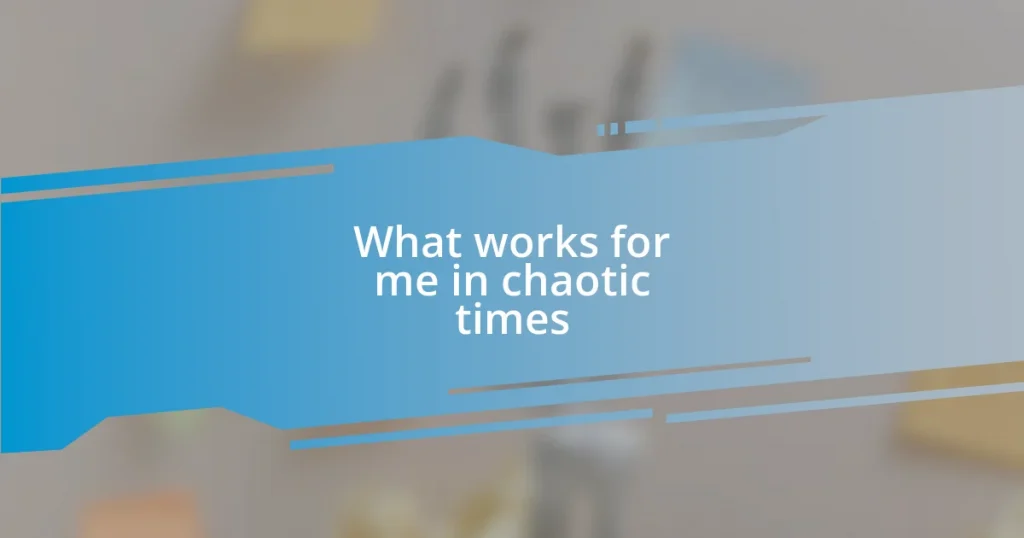Key takeaways:
- Chaos can lead to personal growth by forcing individuals to adapt, reveal strengths, and uncover hidden opportunities.
- Effective stress management strategies include mindfulness meditation, task prioritization, and physical activity, which help create clarity and maintain organization during turbulent times.
- Building resilience involves seeking support from others, reframing negative thoughts, and practicing self-compassion to navigate challenges and foster personal empowerment.
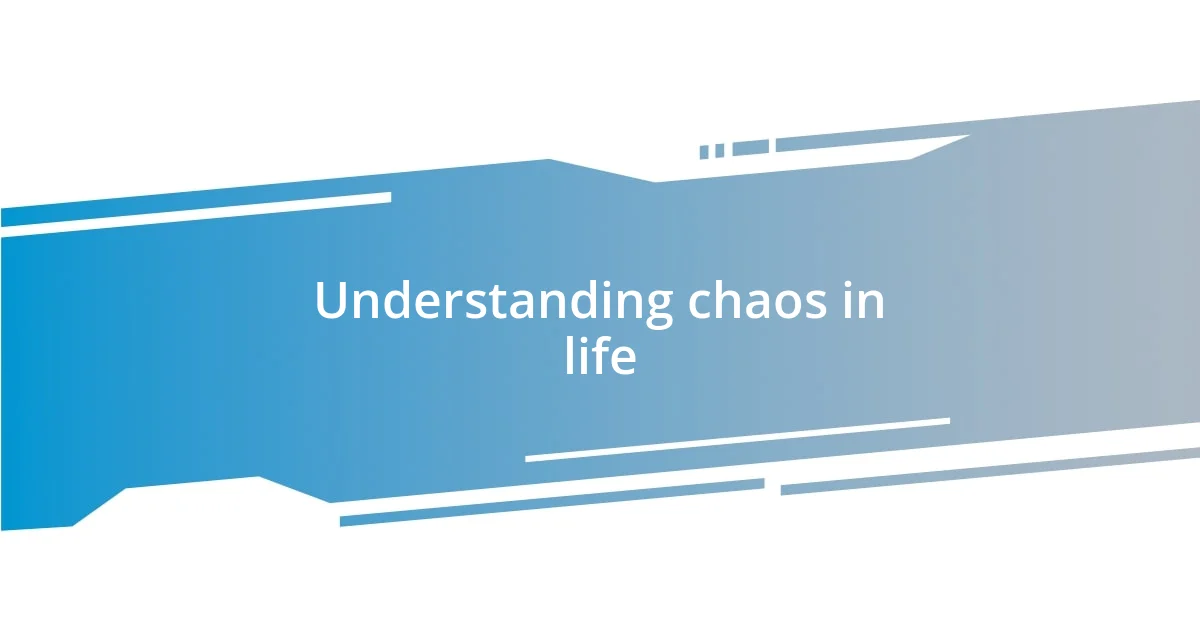
Understanding chaos in life
Chaos is often perceived negatively, yet it’s an essential part of life’s ebb and flow. I remember a particularly hectic period when I was juggling work deadlines, family commitments, and a personal project that felt overwhelming. It made me question—can chaos actually lead to growth? I’ve found that it often does, pushing me to explore new strategies and reset my priorities.
When faced with chaos, I’ve noticed that my instincts kick in, almost like a survival mode. I recall a time when unforeseen events disrupted my carefully crafted plans. Initially, it felt like I was tossed into a storm without a raft. Yet, that experience taught me resilience—an understanding that chaos often forces us to think creatively and adapt.
Reflecting on these moments, I realize that chaos can reveal our true character. It’s during these tumultuous times that I’ve discovered strengths I didn’t know I had. Have you ever felt that way? I’ve learned to embrace the unpredictability, knowing that, in chaos, there’s often a hidden opportunity waiting to be uncovered.
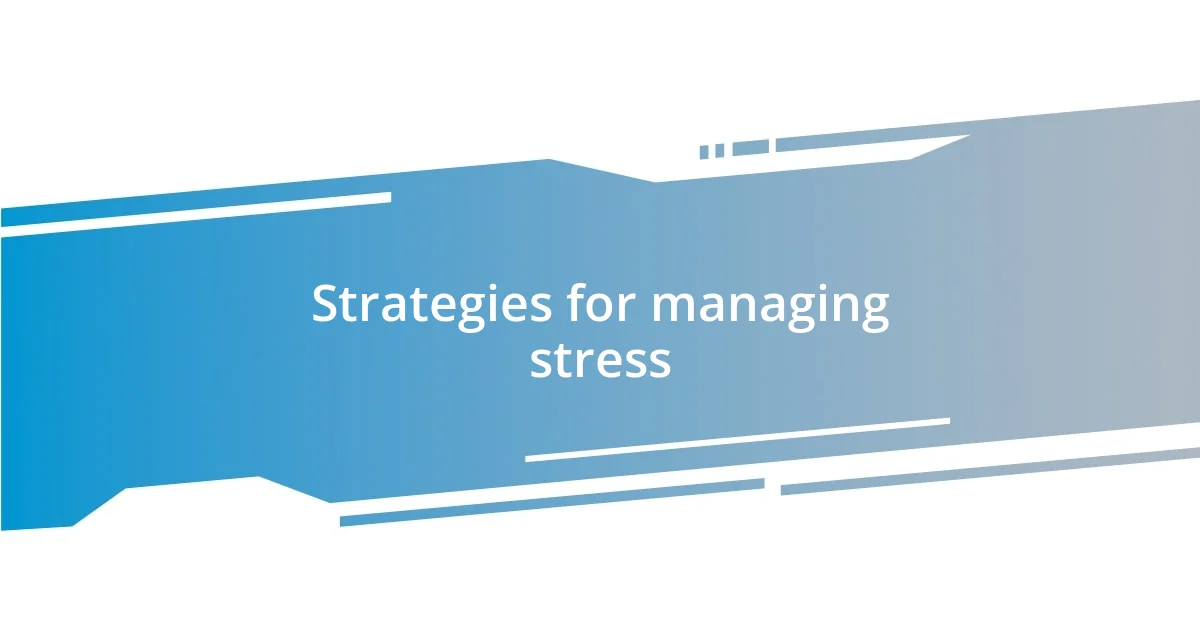
Strategies for managing stress
One effective strategy I’ve embraced for managing stress is mindfulness meditation. When I first started practicing, I was skeptical. However, I remember one afternoon where I felt overwhelmed by a multitude of tasks. As I sat quietly, focusing on my breath, I began to sense a shift within me. Those few minutes of stillness allowed me to regroup my thoughts and tackle my to-do list with clarity. The beauty of mindfulness is that it’s accessible anytime, anywhere, serving as a quick reset in chaotic moments.
Another technique I find helpful is prioritizing tasks. In times of chaos, I’ve experienced the guilty feeling of not being able to do it all. So, I learned to break my responsibilities into bite-sized pieces. This was particularly useful during a challenging project at work. By creating a simple list and focusing on the top three tasks each day, I was able to keep the overwhelm at bay. It’s amazing how just a little organization can transform a racing mind into a more peaceful one.
Physical activity also plays a crucial role in my stress management toolkit. Reflecting on days filled with stress, I often turn to a brisk walk or an evening yoga session. I recall how after a tough week, I decided to spend an hour outdoors. The fresh air and movement released pent-up energy and melted my stress away. Each step I took felt like a step away from chaos, toward a more centered version of myself. What activities help you release stress? It’s worth noting that finding what works for you is key.
| Strategy | Description |
|---|---|
| Mindfulness Meditation | A practice that involves focusing on the present moment, often leading to reduced stress and increased clarity. |
| Task Prioritization | Breaking down responsibilities into manageable pieces, helping to minimize feelings of overwhelm. |
| Physical Activity | Engaging in exercise or movement, which releases endorphins and can significantly lower stress levels. |
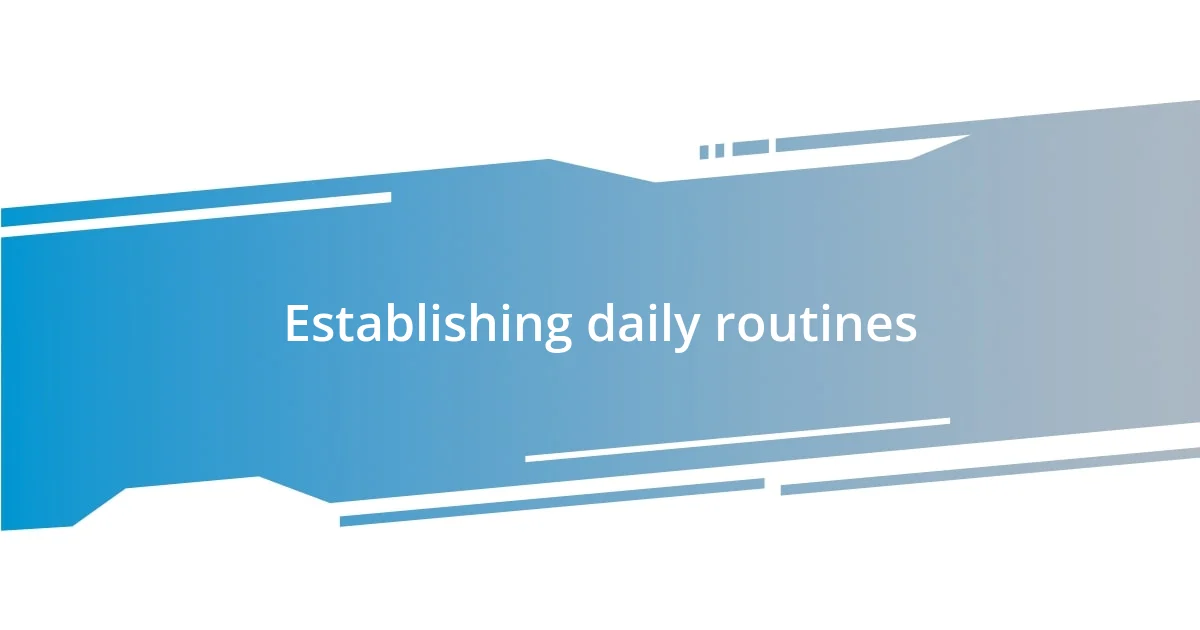
Establishing daily routines
Establishing a daily routine has been a game-changer for me in turbulent times. I naturally gravitate toward structure, and when chaos reigns, a routine acts as my anchor. I once felt lost in a whirlwind of uncertainty, but by setting up a morning ritual that included a warm cup of tea and a few moments of reading, I created a calming start to my day. These little rituals provide comfort and clarity, helping me chart my path through potentially chaotic hours.
Here are some elements I incorporate into my daily routine:
- Consistent Wake-Up Time: I rise at the same time every day to create a sense of stability.
- Morning Mindfulness: A few minutes of meditation or deep breathing helps ground my thoughts.
- Dedicated Work Blocks: I break my work into focused sessions with breaks in between, making tasks feel less daunting.
- Evening Wind-Down: Spending the last hour of my day away from screens allows me to relax and reflect.
- Gratitude Journaling: Writing down a few things I’m thankful for each night fosters a positive mindset, even on chaotic days.
These practices have not only kept me organized but have also instilled a sense of control amid uncertainty. Life is unpredictable, but with a solid routine, I feel more equipped to tackle whatever comes my way.
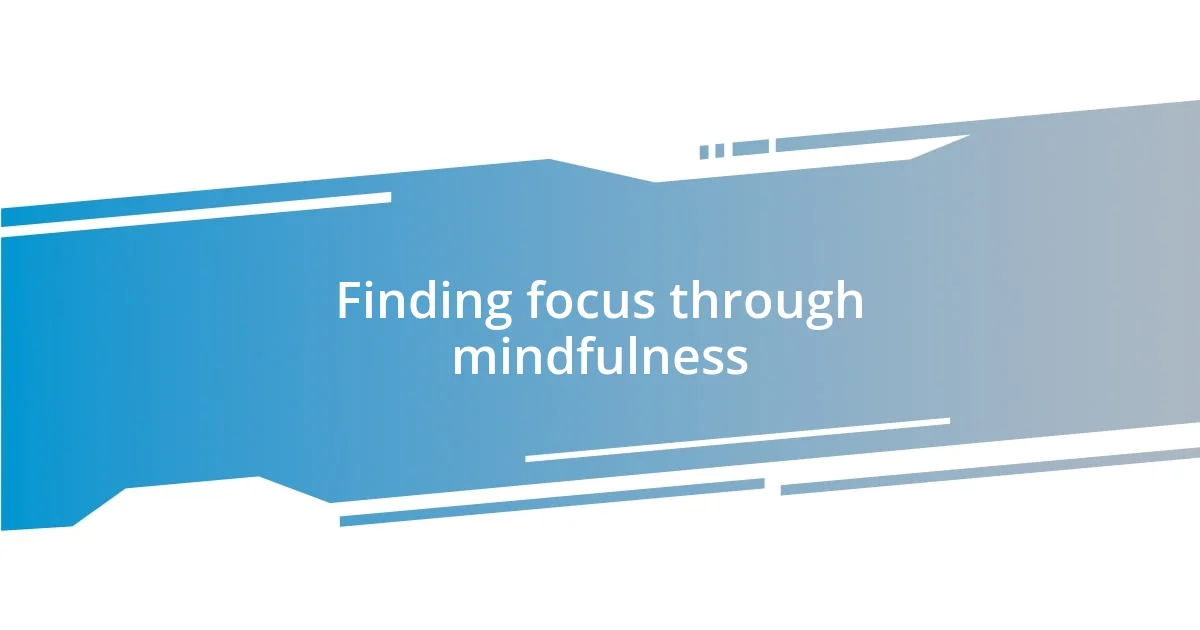
Finding focus through mindfulness
Mindfulness has become my beacon during chaotic times. I recall a particularly hectic day when the noise of deadlines and distractions felt suffocating. I stepped away for just five minutes to focus on my breath, inhaling deeply and exhaling slowly. It was astonishing how that brief moment of mindfulness transformed my racing thoughts into a serene flow, allowing me to re-engage with my tasks more effectively. Have you ever felt the power of a simple pause?
Incorporating mindfulness into my daily routine has shaped my overall outlook. For instance, during moments of intense stress, I create a mini ritual—a cup of herbal tea in hand, I sit quietly and appreciate the warmth and aroma. This sensory experience grounds me, anchoring my scattered thoughts. Sometimes I even close my eyes to fully embrace the moment. By tuning into the present, I find the clarity I need to navigate through the impending chaos.
I’ve also discovered that mindfulness doesn’t have to be limited to meditation. It can be as simple as intentional breathing while I walk or fully immersing myself in a task. Recently, I noticed how focusing on the texture of the paper while writing helped calm my mind. It’s remarkable how engaging our senses can enhance our ability to focus. If we seek moments of mindfulness throughout our day, we might just uncover the stillness we need to thrive in chaos.
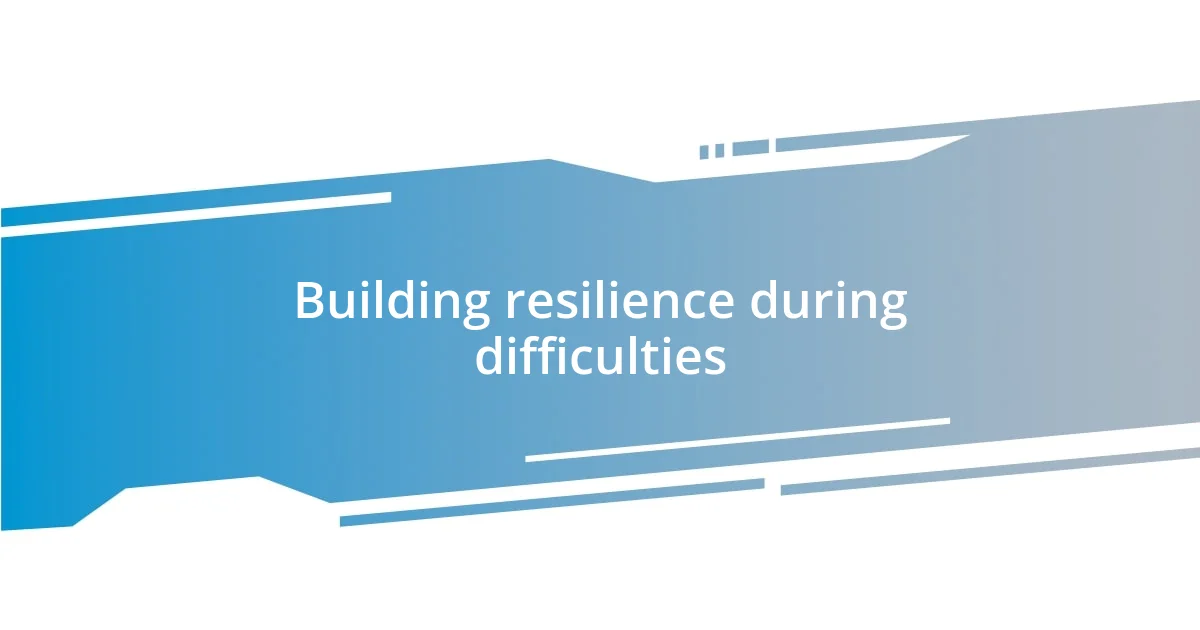
Building resilience during difficulties
Building resilience during difficult times is something I’ve come to value deeply. When faced with challenges, I find that leaning into my support system is crucial. For example, during a particularly trying week last year, I reached out to friends and family through video calls. Their encouragement reminded me that I wasn’t navigating this storm alone. Realizing I had a solid network to lean on gave me strength and reinforced the importance of connection during hardships.
Another strategy that has fortified my resilience is reframing negative thoughts. I recall an incident at work when a project went awry, and I felt overwhelmed by self-doubt. Instead of spiraling into negativity, I paused to reframe the situation, questioning what I could learn from this setback. This shift in perspective not only alleviated my anxiety but also empowered me to tackle the challenge with renewed vigor. Have you ever experienced a moment where changing your narrative helped you cope better?
To further bolster my resilience, I practice self-compassion during tough times. When stress mounts, I remind myself that it’s okay to feel overwhelmed; it’s a natural reaction. Once, after a particularly stressful month, I felt immense guilt for taking a day off to recharge. But reflecting on my need for downtime helped me embrace the idea that self-care is not a luxury—it’s essential for survival in chaos. By treating myself with kindness, I’ve built a mental framework that allows me to bounce back stronger, transforming my response to difficulties into an opportunity for growth.
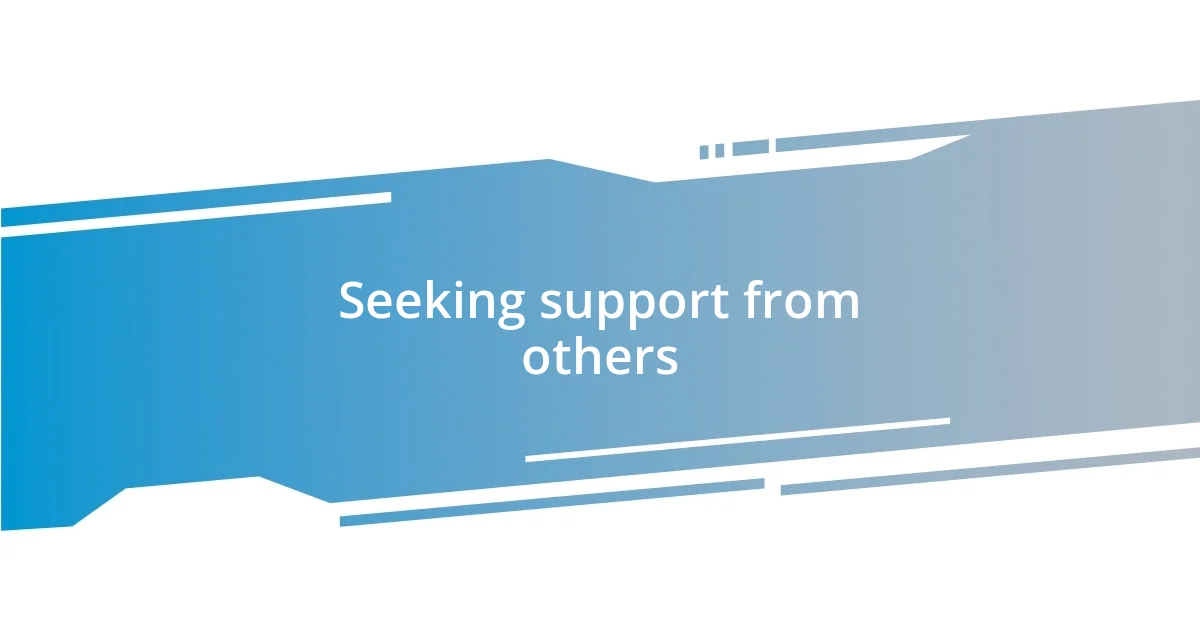
Seeking support from others
Reaching out to others in chaotic times has always been a lifeline for me. I remember a particularly overwhelming day when everything felt like it was spiraling out of control. Instead of burying myself in my thoughts, I decided to call a close friend. The simple act of sharing my feelings helped to lighten the load, reminding me that vulnerability can be a strength.
I’ve also learned the importance of creating a support network. During a challenging period, I formed a small group of friends who would check in on each other regularly. We’d send messages, share memes, or even schedule brief catch-ups over coffee. This connection made a world of difference, illustrating how community can transform individual struggles into shared experiences. Have you ever noticed how a simple message can uplift your spirit?
Moreover, it’s fascinating how seeking support often leads to unexpected insights. Last month, after venting about my stressors during a group call, one of my friends shared a coping strategy that changed my perspective entirely. Listening to their experiences not only validated my feelings but also provided me with new tools to manage chaos. Isn’t it interesting how collaboration can spark solutions that we might not find alone?
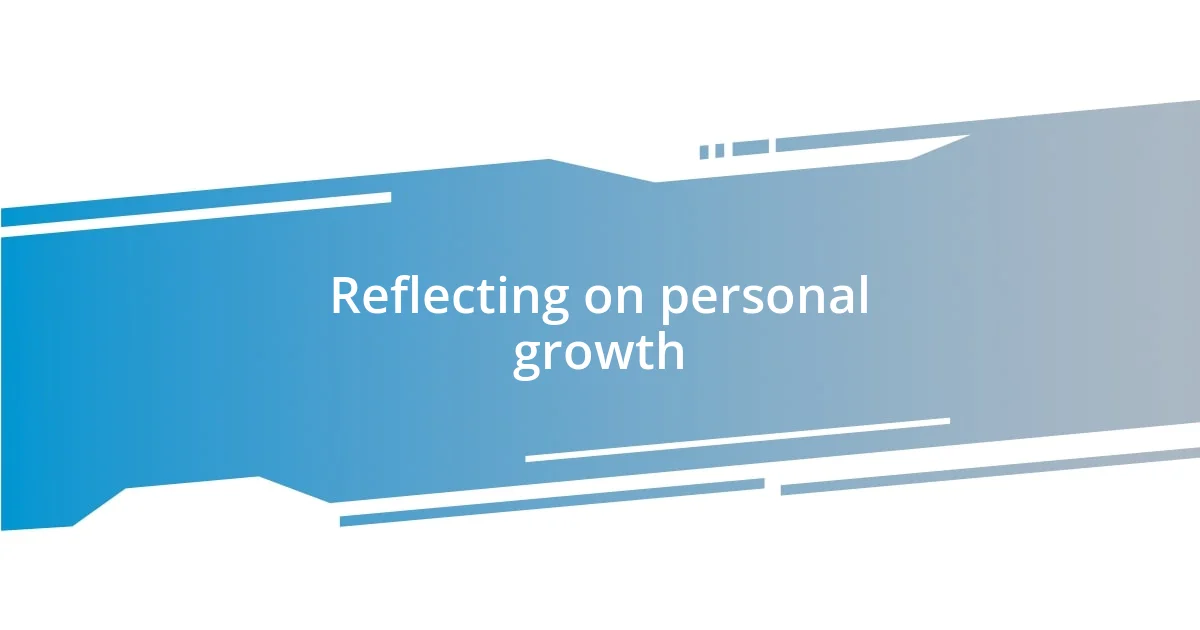
Reflecting on personal growth
Reflecting on personal growth during chaotic times can be a revealing exercise. I remember a moment last year’s lockdown when I felt suffocated by uncertainty. I grabbed my journal and began writing my feelings down. It was in those pages that I discovered the profound ability to process my experiences. What seemed like a jumble of thoughts gradually transformed into insights about myself that I hadn’t recognized before. Have you ever experienced that cathartic release through writing? It can be surprisingly enlightening.
This period of reflection has allowed me to identify patterns in how I cope with stress. Looking back, I see how I’ve developed the habit of prioritizing gratitude, even on the toughest days. For instance, I once decided to list three things I was thankful for each night before bed. It quickly became a healing ritual that shifted my mindset from scarcity to abundance. Through this practice, I’ve learned that even small moments of joy can anchor us amidst the chaos.
Through introspection, I’ve also become more aware of my strengths and vulnerabilities. There was a time when I would shy away from expressing my needs. Now, I’ve learned that it’s okay to ask for help or take breaks when needed. This shift didn’t happen overnight. It took continual self-reflection and, honestly, a few uncomfortable moments. But isn’t it fascinating how vulnerability can lead to authentic connections that foster growth? Embracing who I am, flaws and all, has been one of my most significant sources of empowerment.











